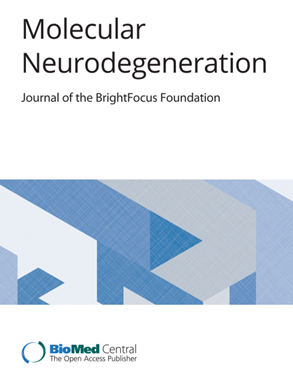Alzheimer's disease neuropathology and its estimation with fluid and imaging biomarkers
IF 17.5
1区 医学
Q1 NEUROSCIENCES
引用次数: 0
Abstract
Alzheimer’s disease (AD) is neuropathologically characterized by the extracellular deposition of the amyloid-β peptide (Aβ) and the intraneuronal accumulation of abnormal phosphorylated tau (τ)-protein (p-τ). Most frequently, these hallmark lesions are accompanied by other co-pathologies in the brain that may contribute to cognitive impairment, such as vascular lesions, intraneuronal accumulation of phosphorylated transactive-response DNA-binding protein 43 (TDP-43), and/or α-synuclein (αSyn) aggregates. To estimate the extent of these AD and co-pathologies in patients, several biomarkers have been developed. Specific tracers target and visualize Aβ plaques, p-τ and αSyn pathology or inflammation by positron emission tomography. In addition to these imaging biomarkers, cerebrospinal fluid, and blood-based biomarker assays reflecting AD-specific or non-specific processes are either already in clinical use or in development. In this review, we will introduce the pathological lesions of the AD brain, the related biomarkers, and discuss to what extent the respective biomarkers estimate the pathology determined at post-mortem histopathological analysis. It became evident that initial stages of Aβ plaque and p-τ pathology are not detected with the currently available biomarkers. Interestingly, p-τ pathology precedes Aβ deposition, especially in the beginning of the disease when biomarkers are unable to detect it. Later, Aβ takes the lead and accelerates p-τ pathology, fitting well with the known evolution of biomarker measures over time. Some co-pathologies still lack clinically established biomarkers today, such as TDP-43 pathology or cortical microinfarcts. In summary, specific biomarkers for AD-related pathologies allow accurate clinical diagnosis of AD based on pathobiological parameters. Although current biomarkers are excellent measures for the respective pathologies, they fail to detect initial stages of the disease for which post-mortem analysis of the brain is still required. Accordingly, neuropathological studies remain essential to understand disease development especially in early stages. Moreover, there is an urgent need for biomarkers reflecting co-pathologies, such as limbic predominant, age-related TDP-43 encephalopathy-related pathology, which is known to modify the disease by interacting with p-τ. Novel biomarker approaches such as extracellular vesicle-based assays and cryptic RNA/peptides may help to better detect these co-pathologies in the future.阿尔茨海默病的神经病理学及其与液体和成像生物标志物的估计
阿尔茨海默病(AD)的神经病理学特征是淀粉样蛋白-β肽(Aβ)的细胞外沉积和异常磷酸化tau (τ)蛋白(p-τ)的神经元内积累。最常见的是,这些标志性病变伴有大脑中其他可能导致认知障碍的共病,如血管病变、磷酸化的交互反应dna结合蛋白43 (TDP-43)和/或α-突触核蛋白(αSyn)聚集体的神经元内积累。为了估计这些阿尔茨海默病和患者共病的程度,已经开发了几种生物标志物。特异性示踪剂通过正电子发射断层扫描靶向并可视化Aβ斑块,p-τ和αSyn病理或炎症。除了这些成像生物标志物外,反映ad特异性或非特异性过程的脑脊液和血液生物标志物检测要么已经在临床使用,要么正在开发中。在这篇综述中,我们将介绍阿尔茨海默病大脑的病理病变,相关的生物标志物,并讨论各自的生物标志物在多大程度上估计死后组织病理学分析确定的病理。很明显,目前可用的生物标志物无法检测到Aβ斑块和p-τ病理的初始阶段。有趣的是,p-τ病理先于Aβ沉积,特别是在疾病开始时,生物标志物无法检测到它。随后,Aβ起主导作用,加速p-τ病理,与已知的生物标志物随时间的演变非常吻合。一些共同病理目前仍缺乏临床确定的生物标志物,如TDP-43病理或皮质微梗死。总之,AD相关病理的特异性生物标志物可以基于病理生物学参数对AD进行准确的临床诊断。虽然目前的生物标志物是对各自病理的极好测量,但它们无法检测疾病的初始阶段,因此仍然需要对大脑进行死后分析。因此,神经病理学研究仍然是了解疾病发展,特别是在早期阶段至关重要。此外,迫切需要反映共同病理的生物标志物,例如边缘显性,年龄相关的TDP-43脑病相关病理,已知其通过与p-τ相互作用来修饰疾病。新的生物标志物方法,如基于细胞外囊泡的检测和隐RNA/肽,可能有助于在未来更好地检测这些共同病理。
本文章由计算机程序翻译,如有差异,请以英文原文为准。
求助全文
约1分钟内获得全文
求助全文
来源期刊

Molecular Neurodegeneration
医学-神经科学
CiteScore
23.00
自引率
4.60%
发文量
78
审稿时长
6-12 weeks
期刊介绍:
Molecular Neurodegeneration, an open-access, peer-reviewed journal, comprehensively covers neurodegeneration research at the molecular and cellular levels.
Neurodegenerative diseases, such as Alzheimer's, Parkinson's, Huntington's, and prion diseases, fall under its purview. These disorders, often linked to advanced aging and characterized by varying degrees of dementia, pose a significant public health concern with the growing aging population. Recent strides in understanding the molecular and cellular mechanisms of these neurodegenerative disorders offer valuable insights into their pathogenesis.
 求助内容:
求助内容: 应助结果提醒方式:
应助结果提醒方式:


